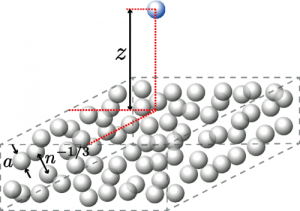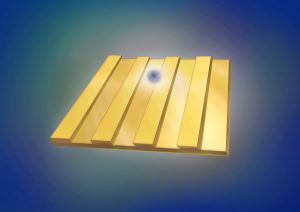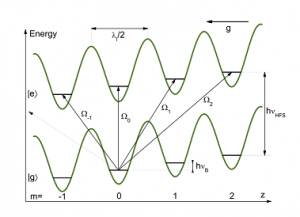CASIMIR-POLDER FORCES
PEOPLE
Romain Guérout
Astrid Lambrecht
Serge Reynaud
Casimir-Polder and van der Waals forces are directly parented to Casimir forces as they result from the interaction with vacuum fluctuations of atoms, molecules or nanoparticles. They have been studied for a long time in atomic and molecular physics and play also an important role in various domains and interfaces of physics, such as condensed matter and surface physics, chemical and biological physics, micro- and nanotechnology.
Our group has been involved in the FORCA-G experiment, in the group of Franck Pereira at SYRTE (CNRS, Observatoire de Paris, UPMC), aiming at high precision measurements of the Casimir-Polder and gravitational interactions between neutral atoms and a massive dielectric mirror.
We have also worked on theoretical developments on the Casimir-Polder interaction and its consequences for atoms, molecules or nano-particles, in free space or in the vicinity of a surface. In particular, atoms or molecules can be used as local probes of the vacuum as it is modified when they are placed above nanostructured surfaces .
Casimir-Polder forces in optical lattices : FORCA-G
The FORCA-G experiment aims at performing high precision measurements of the Casimir-Polder and gravitational interactions between neutral atoms and a massive dielectric mirror. Ultimately, it aims at establishing accurate constraints in the search of hypothetical deviations from the Newtonian law of gravitation at short length scales, reason why an accurate knowledge of the Casimir-Polder interaction is also needed. The principle of the experiment is based on the theoretical proposition of P. Wolf et al.
- From optical lattice clocks to the measurement of forces in the Casimir regime, P. Wolf, P. Lemonde, A. Lambrecht, S. Bize, A. Landragin, A. Clairon, Phys. Rev. A 75 063608 (2007)
In the experiment performed in the group of Franck Pereira at SYRTE (CNRS, Observatoire de Paris, UPMC), a cloud of cold rubidium atoms is trapped in a vertical optical lattice. The atoms far from the mirror surface experience a gravity-tilted periodic potential, with quantum states known as Wannier-Stark states. Unlike Bloch states, they are localized thanks to the gravity tilt and can be labeled with a lattice site. The energy difference between successive Wannier-Stark states is constant and proportional to the acceleration of gravity felt by the atoms.
Atomic interferometry involving transitions between different lattice sites provides a measure of the acceleration of gravity. When the atoms are close to the mirror surface, the atoms experience the Casimir-Polder interaction in addition to the gravity and the trapping potentials. This additional interaction modifies the Wannier-Stark states and their energies.
Our group is responsible for the accurate determination of the Casimir-Polder potential between atoms and the complex, multilayered dielectric mirror used in the FORCA-G experiment. We characterize the complex spectrum of the Wannier-Stark states modified by the proximity with the surface. Eventually, atomic interferometry done with those atoms near the surface mirror will provide a measure of the Casimir-Polder interaction.
- Surface-modified Wannier-Stark states in a one-dimensional optical lattice, A. Maury, M. Donaire,M.-P. Gorza, A. Lambrecht, R. Guerout, , Phys. Rev. A 94 053602 (2016)
Casimir-Polder forces with excited atoms

Graphical representation of the van der Waals interaction between a 87Rb atom in state 5P1/2 and a 40K atom in its ground state, in the far field. The black line corresponds to a snapshot of the interaction at T=3ps, where the contributions of the transitions D1 et D2 of the 40K atom add up in phase. The long-range period corresponds to the detuning. The red line corresponds to the time average of the interaction.
Van der Waals (vdW) forces between neutral atoms and molecules are ubiquitous in nature. They mediate, for instance, the assembling of molecules in polymers. When pairs of atoms are driven through Rydberg states, the vdW interaction gives rise to the so-called Rydberg blockade, which may be exploited in the design of quantum gates. At a fundamental level, vdW forces are among the simplest phenomena explained in terms of quantum vacuum fluctuations.
A long-standing debate exists in the literature regarding the features of the interaction between dissimilar atoms, one of which is suddenly excited while the other remains in its ground state. We have shown that the exchange of resonant photons makes this interaction inherently time-dependent (see the figure on the right column).
Using time-dependent quantum perturbation theory, we have found that the vdW potential of the excited atom possesses both temporal and spatial oscillations. Spatially oscillating terms depend on the resonant frequencies of both atoms, while the frequency of the time oscillations is given by their detuning. A proper account of causality is found essential in order to obtain the correct result.
- Quasiresonant van der Waals Interaction between Nonidentical Atoms, M. Donaire, R Guerout and A Lambrecht, Phys. Rev. Lett. 115 033201 (2015)
Fluctuations of Casimir-Polder forces

Casimir-Polder interaction between a dielectric sphere and a semi-infinite disordered medium. The disordered medium consists of a collection of dielectric spheres whose positions are uniformly distributed in space.
In collaboration with Nicolas Cherroret of the group Complex Quantum Systems at LKB, we have developed a general approach to study the statistical fluctuations of the Casimir potential felt by an atom approaching a dielectric disordered medium, modeling the disordered medium as a collection of dielectric spheres whose positions are uniformly distributed in space.
Starting from a microscopic model for the disorder, we calculated the variance of potential fluctuations in the limit of a weak density of heterogeneities. We showed that fluctuations are essentially governed by scattering of the radiation on a single heterogeneity, and that they become larger than the average value predicted by effective medium theory at short distances.
- Fluctuations of the Casimir potential above a disordered medium, N. Cherroret, R. Guérout, A Lambrecht, S Reynaud, Eur. Phys. J. C 69 (2015) 9
We then explored the statistical properties of this Casimir-Polder interaction between a dielectric sphere and a three-dimensional heterogeneous medium, by means of extensive numerical simulations based on the scattering theory of Casimir forces. The simulations allowed us to confirm previous predictions for the mean and standard deviation of the Casimir potential, and gave us access to its full distribution function in the limit of a dilute distribution of heterogeneities. These predictions were compared with a simple statistical model based on a pairwise summation of the individual contributions of the constituting elements of the medium.
- Statistical approach to Casimir-Polder potentials in heterogeneous media, N. Cherroret, R. Guérout, A Lambrecht, S Reynaud, Phys.Phys. Rev. A 92 (2015) 042513
We also studied the spatial fluctuations of the Casimir-Polder force experienced by an atom or a small sphere moved above a metallic plate at fixed separation distance. We demonstrated that unlike the mean force, the magnitude of these fluctuations crucially relies on the relaxation of conduction electron in the metallic bulk, and even achieves values that differ by orders of magnitude depending on the amount of dissipation. We also discovered that fluctuations suffer a spectacular decrease at large distances in the case of nonzero temperature.
- Casimir-Polder force fluctuations as spatial probes of dissipation in metals, N. Cherroret, P.-P. Crépin, R. Guérout, A Lambrecht, S Reynaud, EPL, 117 63001 (2017)
Casimir-Polder forces in a structured quantum vacuum

Schematic representation of a configuration with an atom or a molecule above a nano-corrugated plate.
Atoms or molecules placed above nanostructured surfaces can be used as local probes of the vacuum as it is modified by the surface structure.
The scattering approach provides an exact analytical expression for the dispersive Casimir-Polder potential between a ground-state atom and a rectangular grating, for arbitrary values of the grating amplitude and period, and of the atom-grating distance
- Dispersive interactions between atoms and nonplanar surfaces, R. Messina, D. A. R. Dalvit, P.A. Maia Neto, A. Lambrecht, and S. Reynaud, Phys. Rev. A 80, 022119 (2009)
When the separation distance is large enough, the potential tends to become a sinusoidal function along the direction transverse to the grooves. This is due to the fact that the higher the harmonic Fourier components of the wave-vector the faster they decay far from the surface. Comparing the exact results with the ones obtained for the potential for a flat surface taken at the local atom-surface distance (proximity force approximation) reveals that the latter overestimates the potential strength above the plateau, but underestimates it above the groove. The deviation increases strongly as the atom is laterally displaced closer to a corner, where the presence of the ridge walls have a stronger effect
- Casimir-Polder interaction between an atom and a dielectric grating, Contreras-Reyes A. M., Guérout R., Neto P. A. M., Dalvit D. A. R., Lambrecht A., Reynaud S., Phys. Rev. A 82, 052517 (2010)
Disordered geometrical boundaries such as rough surfaces induce profound modifications to the mode spectrum of quantum vacuum. In analogy to Anderson localization of waves induced by a random potential, the Casimir-Polder interaction between a cold atomic sample and a rough surface also produces localization phenomena. These effects, that represent a macroscopic manifestation of disorder in quantum vacuum, should be observable with Bose-Einstein condensates expanding in proximity of rough surfaces.
- Disorder in Quantum Vacuum: Casimir-Induced Localization of Matter Waves, Moreno G. A., Messina R., Dalvit D. A. R, Lambrecht A., Neto P., Reynaud S., Phys. Rev. Lett. 105, 210401 (2010)
A rotating corrugated material plate can be used to stir, through the Casimir-Polder interaction, quantized vortices in an harmonically trapped Bose-Einstein condensate. The emergence of such vortices within the condensate cannot be explained with a computation of the Casimir-Polder potential based on the pairwise summation approach or on the proximity force approximation. It thus appears as a quantum vacuum torque, a genuine signature of non-trivial geometry effects on vacuum fluctuations,which is strong enough to provide a contactless transfer of angular momentum to the condensate.
- Driving quantized vortices with quantum vacuum fluctuations, Impens F., Contreras-Reyes A. M., Maia Neto P. A., Dalvit D. A. R, Guérout R., Lambrecht A., Reynaud S., EPL 92, 40010 (2010)
Nanospheres above a surface
The Casimir interaction between a dielectric nano-sphere and a metallic plate is of particular interest for the study of quantum states of nano-particles in the vicinity of surfaces.We have obtained exact numerical results by using the multiple scattering theory developed for the study of Casimir forces in the plane-sphere geometry.
Analytical asymptotic forms have been derived for small spheres and large or small distances, which offers the possibility to investigate the transition between bulk mirrors and atoms. The usual Casimir-Polder formula is recovered at the limit of vanishingly small spheres, while an expression that behaves better at small distances (proportional to the inverse distance and not to the third power of the inverse distance) is found for any finite value of the radius.
- Casimir interaction between a dielectric nano-sphere and a metallic plane, A. Canaguier-Durand, A. Gérardin, R. Guérout, P.A. Maia Neto, V.V. Nesvizhevsky, A. Yu. Voronin, A. Lambrecht, and S. Reynaud, Phys. Rev. A 83, 032508 (2011)
Some novel applications of this study have been investigated using ultra-cold neutrons (UCN), in a collaboration with Valery Nesvizhevsky and his colleagues at Institut Laue-Langevin (ILL) in Grenoble, Lebedev Institute in Moscow and JINR in Dubna. They are described in a dedicated page.


